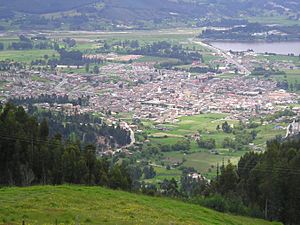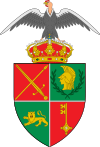Paipa facts for kids
Quick facts for kids
Paipa
|
|||
|---|---|---|---|
|
Municipality and town
|
|||

View of Paipa
|
|||
|
|||

Location of the municipality and town of Paipa in the Boyacá department of Colombia
|
|||
| Country | |||
| Department | Boyacá Department | ||
| Province | Tundama Province | ||
| Founded | 19 February 1602 | ||
| Founded by | Luís Enríquez | ||
| Area | |||
| • Municipality and town | 305.1 km2 (117.8 sq mi) | ||
| • Urban | 4.63 km2 (1.79 sq mi) | ||
| Elevation | 2,525 m (8,284 ft) | ||
| Population
(2018 census)
|
|||
| • Municipality and town | 33,535 | ||
| • Density | 109.915/km2 (284.68/sq mi) | ||
| • Urban | 20,021 | ||
| • Urban density | 4,324/km2 (11,200/sq mi) | ||
| Time zone | UTC-5 (Colombia Standard Time) | ||
| Website | Official website: http://www.paipa-boyaca.gov.co/ | ||
Paipa is a lively town and municipality in Colombia. It's located in the Boyacá Department, a region known for its beautiful landscapes. Paipa is part of the Tundama Province. It shares its borders with towns like Duitama, Firavitoba, Tibasosa, Sotaquirá, and Tuta.
Contents
Exploring Paipa's Geography
Paipa is nestled in the Eastern Ranges of the Colombian Andes. It sits about 48 kilometers (30 miles) northeast of Tunja. Tunja is the capital city of the Boyacá department. Paipa is a major tourist spot in the area. It has many large hotels and famous hot springs.
Paipa's Climate and Weather
Paipa is located at an elevation of 2,525 meters (8,284 feet) above sea level. This high location gives it a mild subtropical highland climate. The average temperature in Paipa is around 14 °C (57 °F). This cool and pleasant weather makes it a great place to visit.
The Story Behind Paipa's Name
The name Paipa comes from the cacique (leader) of the Paipa people. These were the original inhabitants of this land.
A Look at Paipa's History
Before the Spanish arrived in the 1530s, the Muisca people lived in Paipa. The Muisca had different rulers. The cacique of Paipa was loyal to the Tundama of Tundama. In 1539, the Spanish explorer Gonzalo Jiménez de Quesada visited Paipa. He was looking for the famous Sun Temple.
Founding of Modern Paipa
Modern Paipa was officially founded on February 19, 1602. It was established by a person named Luís Enríquez. The first building in Paipa was a church. It was built where the main cathedral stands today. This church also served as a police station and a place to collect taxes.
Paipa Becomes a Tourist Hotspot
Paipa's journey to becoming a tourist city began in 1825. Specialists came to study the local mineral waters. Tourism really started to grow after 1852. That's when a government committee, led by General Agustín Codazzi, explored the area's natural resources.
In 1938, mineral water pools and spas were built. This officially launched the local tourism industry. Lake Sochagota was created in 1955, which further boosted tourism. By 1960, the Departmental Assembly declared Paipa a "tourist capital."
Changes and Growth in Paipa
In 1953, a coal-fired power plant was built in Paipa. This brought many new people to the city. As Paipa grew, some of its old buildings were replaced. The traditional main square changed to have more modern buildings.
In 1990, a new sports and cultural complex was built. It included a music venue called Concha Acústica "Valentín Garcia." Around 1995, Paipa started to see urban decay. This was due to national policies that aimed to quickly industrialize cities. To fix this, new housing areas are now being built in the northern part of the city.
Paipa's Economy and Jobs
The main ways people make a living in Paipa are through tourism and agriculture. Many farms raise livestock and produce dairy products. Farmers also grow crops like oats, barley, maize, wheat, and potatoes. The TermoPaipa power plant, which uses coal, provides electricity for the entire region. The city also has its own airport, Juan José Rondón Airport.
Fun Things to Do in Paipa
Paipa is full of interesting places to visit. These include Lake Sochagota, the Ranchería nature reserve, and the historic Vargas Swamp. You can also see the beautiful church, the Casona del Salitre, and Jaime Rook park. This park is named after James Rooke.
Discover Lake Sochagota
Lake Sochagota is a popular spot for Colombians. It's also starting to attract visitors from other countries. You can enjoy activities like water-skiing and kayaking on the lake. Many people also like to run or cycle around its edges.
Visit Vargas Swamp
Vargas Swamp is a very important historical site. The Battle of Vargas Swamp took place here on July 25, 1819. This battle was a key moment in Colombia's fight for independence. There's a monument here that honors the 14 lancers who fought bravely in the battle. It was created by Rodrigo Arenas Betancur.
Relax at Paipa Thermal Baths
The thermal bath area in Paipa is huge, covering about 5 hectares (12 acres). It has many pools, both for the public and for private use. You'll also find hotels, sports facilities, shops, and cafes here. The warm water comes from an underground lake. It flows to the surface in this area and is then sent to different places.
Explore Casona del Salitre
Just outside of Paipa, you can find the Casona del Salitre. This is a beautifully restored colonial hacienda, which is a large estate. It's considered a national monument and also operates as a hotel.
Images for kids
See also
 In Spanish: Paipa para niños
In Spanish: Paipa para niños







